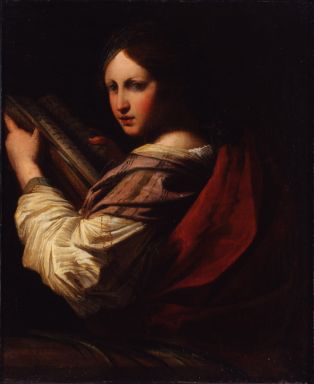- Découvrez les collections
- Notice d'oeuvre



Aller plus loin :
Haarlem, vers 1610 ; Haarlem, 1671 ou 1672
H. 45,5 cm ; l. 42,9 cm (sans cadre) ; H. 55,1 cm ; l. 52,2 cm (avec cadre)
M0536_2000.3.1
Sarah et Abraham ne parvenant pas à avoir de descendance, Sarah fait de sa servante Agar la concubine d’Abraham. De cette union naît Ismaël. L’iconographie de cette œuvre reste incertaine et de nombreuses hypothèses existent sur le sens de la scène représentée, vraisemblablement tirée de l’Ancien Testament. On reconnaît une scène de sacrifice grâce au feu allumé sur l’autel et au personnage en prière. Un serviteur apporte également des offrandes à droite. Par contre, il est difficile d’identifier avec certitude les autres personnages. De plus, la Bible ne mentionne pas de sacrifice de remerciement dans les textes concernant les enfants d’Abraham. De Wet a probablement été l’élève de Rembrandt en 1630-1632. Établi à Haarlem, il se spécialise dans la représentation de scènes bibliques, ou issues de la littérature antique et contemporaine. Il accorde une grande attention au jeu de clair-obscur ainsi qu’aux couleurs, au rendu des étoffes et aux détails vestimentaires relevés de quelques pointes de lumière, une technique que l’on observe également chez Rembrandt, dont on retrouve l’intensité chez de Wet.
Sarah and Abraham were unable to produce offspring and so Sarah told Abraham to take her servant Hagar as his concubine. They conceived the child Ishmael. The iconography of this work is not clear and a number of theories have been advanced about the meaning of the scene depicted, which is in all probability from the Old Testament. The fire burning on the altar and the praying figure suggest a sacrificial scene. A servant can also be seen on the right bringing offerings. However, it is difficult to identify the other figures positively. Furthermore, the Bible makes no mention of a sacrifice of thanksgiving in the scripture passages relating to the children of Abraham. De Wet was probably a student of Rembrandt in 1630-1632. He was based in Haarlem and specialised in scenes from the Bible and Classical and contemporary literature. He paid particular attention to the interplay of chiaroscuro, to colours and to reproducing fabrics and details of clothing emphasised with a few touches of light, a technique which is also found in the work of Rembrandt, whose intensity de Wet emulated.


 Copyright© WebMuseo 2017 - 2024
Copyright© WebMuseo 2017 - 2024